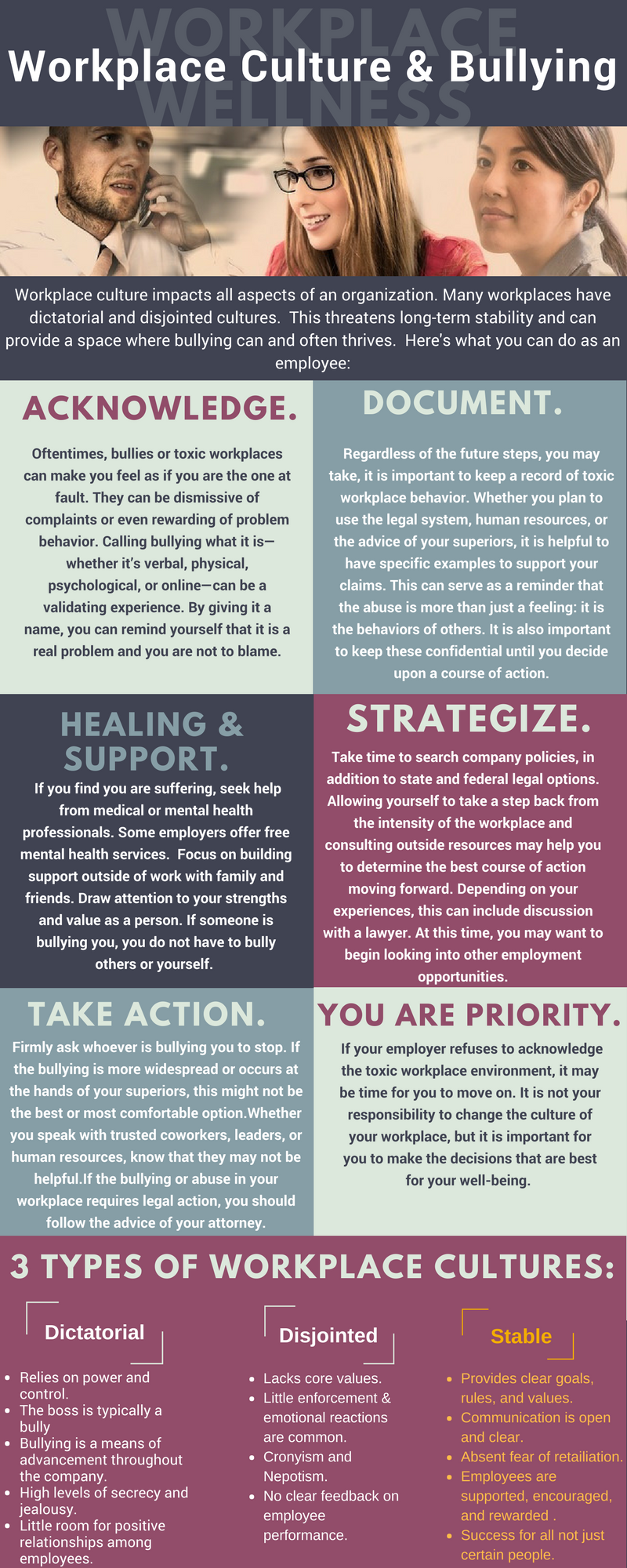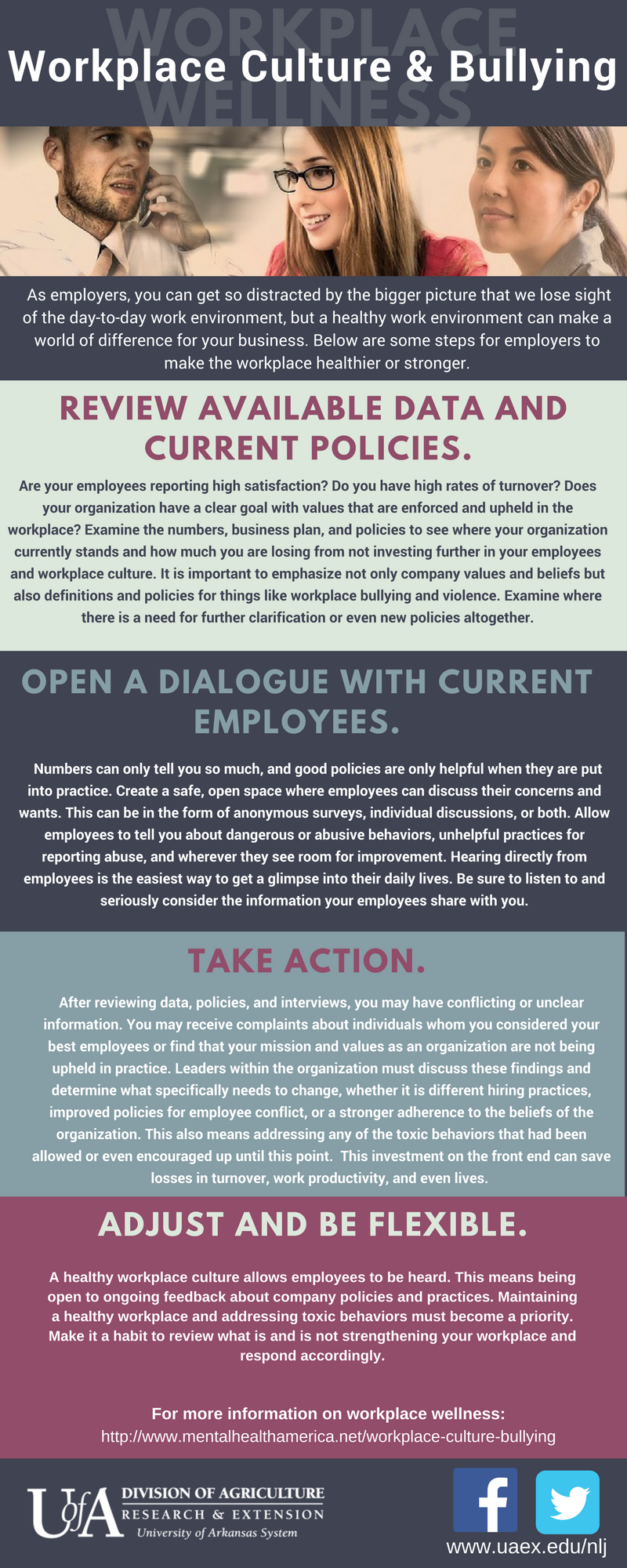
Navigating Life's Journey Blog
Helping others navigate this journey of Life!
A weekly blog from the Family & Consumer Sciences Department
Workplace Wellness:Culture and Bullying

Workplace culture impacts all aspects of an organization. Many workplaces have dictatorial and disjointed cultures. This threatens long-term stability and can provide a space where bullying can and often thrives.
According to Mental Health America, research shows that many people experience workplace bullying. Approximately two out of every five people have been bullied at work. Almost half of those targeted at work suffer stress related health problems. The bullying can be verbal, psychological, physical, or online. It can also include blacklisting from future employment opportunities. These high-stress situations can have serious effects on an individual’s physical health, mental health, and relationships. What’s more, fear of retaliation or even job loss prevents many people from reporting abusive behavior at work. Even when the behavior is reported, employers often mishandle responses or justify bullying as a “leadership style.”
3 Types of Workplace Culture
In his book, From Bully to Bull's Eye, Andrew Faas dsecribes three types of workplace cultures: dictatorial, disjointed, and stable.
Dictatorial Culture:
- Relies on power and control.
- The boss is typically a bully
- Bullying is a means of advancement throughout the company.
- High levels of secrecy and jealousy.
- Little room for positive relationships among employees.
Disjointed Culture:
- Lacks core values.
- Little enforcement & emotional reactions are common.
- Cronyism and Nepotism.
- No clear feedback on employee performance.
Stable Culture:
- Provides clear goals, rules, and values.
- Communication is open and clear.
- Absent fear of retailiation.
- Employees are supported, encouraged, and rewarded .
- Success for all not just certain people.
What can I do as an employee?
Whether you are a target or an observer, workplace bullying has toxic effects. If bullying of any sort is occurring in your workplace, there are steps you can take to address it.
- Acknowledge that there is a problem. Oftentimes, bullies or toxic workplaces can make you feel as if you are the one at fault. They can be dismissive of complaints or even rewarding of problem behavior. Calling bullying what it is—whether it’s verbal, physical, psychological, or online—can be a validating experience. By giving it a name, you can remind yourself that it is a real problem and you are not to blame.
- Document the behavior. Regardless of the future steps, you may take, it is important to keep a record of toxic workplace behavior. Whether you plan to use the legal system, human resources, or the advice of your superiors, it is helpful to have specific examples to support your claims. This can serve as a reminder that the abuse is more than just a feeling: it is the behaviors of others. It is also important to keep these confidential until you decide upon a course of action.
- Focus on healing and support. If you find you are suffering, seek help from medical or mental health professionals. Some employers offer free mental health services. Focus on building support outside of work with family and friends. Draw attention to your strengths and value as a person. If someone is bullying you, you do not have to bully others or yourself.
- Strategize. Take time to search company policies, in addition to state and federal legal options. Allowing yourself to take a step back from the intensity of the workplace and consulting outside resources may help you to determine the best course of action moving forward. Depending on your experiences, this can include discussion with a lawyer. At this time, you may want to begin looking into other employment opportunities.
- Take action. Firmly ask whoever is bullying you to stop. If the bullying is more widespread or occurs at the hands of your superiors, this might not be the best or most comfortable option.Whether you speak with trusted coworkers, leaders, or human resources, know that they may not be helpful.If the bullying or abuse in your workplace requires legal action, you should follow the advice of your attorney.
- Remember, you are your priority. If your employer refuses to acknowledge the toxic workplace environment, it may be time for you to move on. It is not your responsibility to change the culture of your workplace, but it is important for you to make the decisions that are best for your well-being.
What can I do as an employer?
As employers, you can get so distracted by the bigger picture that we lose sight of the day-to-day work environment, but a healthy work environment can make a world of difference for your business. Below are some steps for employers to make the workplace healthier or stronger.
- Review available and current policies. Are your employees reporting high satisfaction? Do you have high rates of turnover? Does your organization have a clear goal with values that are enforced and upheld in the workplace? Examine the numbers, business plan, and policies to see where your organization currently stands and how much you are losing from not investing further in your employees and workplace culture. It is important to emphasize not only company values and beliefs but also definitions and policies for things like workplace bullying and violence. Examine where there is a need for further clarification or even new policies altogether.
- Open a dialogue with current employees. Numbers can only tell you so much, and good policies are only helpful when they are put into practice. Create a safe, open space where employees can discuss their concerns and wants. This can be in the form of anonymous surveys, individual discussions, or both. Allow employees to tell you about dangerous or abusive behaviors, unhelpful practices for reporting abuse, and wherever they see room for improvement. Hearing directly from employees is the easiest way to get a glimpse into their daily lives. Be sure to listen to and seriously consider the information your employees share with you.
- Take action. After reviewing data, policies, and interviews, you may have conflicting or unclear information. You may receive complaints about individuals whom you considered your best employees or find that your mission and values as an organization are not being upheld in practice. Leaders within the organization must discuss these findings and determine what specifically needs to change, whether it is different hiring practices, improved policies for employee conflict, or a stronger adherence to the beliefs of the organization. This also means addressing any of the toxic behaviors that had been allowed or even encouraged up until this point. This investment on the front end can save losses in turnover, work productivity, and even lives.
- Adjust and be flexible. A healthy workplace culture allows employees to be heard. This means being open to
ongoing feedback about company policies and practices. Maintaining a healthy workplace
and addressing toxic behaviors must become a priority.
Make it a habit to review what is and is not strengthening your workplace and respond accordingly.
Reference: Mental Health America

